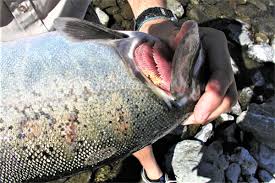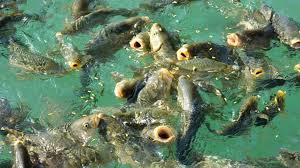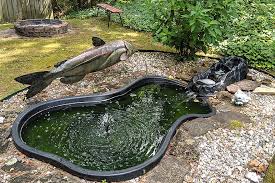This article discusses the public health implications of livestock-fish integration. The focus is on how integrated systems, as well as stand-alone livestock and fish production, affect public health. Historical comparisons between human health and livestock production are made, with attention given to modern threats, including how inputs to these systems may directly or indirectly affect public health.
The identification of hazards and the assessment of risks from pathogens such as bacteria, viruses, and parasites are examined, alongside the involvement of integrated farming in influenza pandemics. Additionally, the importance of chemical and biological hazards, including the current debate on antimicrobial resistance and the risks from bioaccumulation and toxic algal blooms, is highlighted.
General Considerations in Public Health and Fish Pond Management

Public health concerns affect both producers and consumers of fish and are tied to the broader issues of food production, processing, and delivery systems. There are established links between fish or livestock production and health in terms of communicable diseases, non-communicable diseases, malnutrition, and injury. While the availability of low-cost fish and livestock products is crucial for nutrition, this must be balanced with the possible risks.
Diverse threats to public health from livestock and aquaculture exist, with livestock and fish being implicated in occasional influenza pandemics. Infectious diseases have historically entered human populations through animals, and while pathogens in warm-blooded animals generally do not cause diseases in fish, the potential role of cultured fish in transferring pathogens between livestock and humans, especially in less developed countries, is significant.
Livestock and fish play roles in both the passive and active transfer of diseases and parasites to humans. Technologies and chemicals used in fish and livestock production introduce a new set of risks, with products like antimicrobials and pesticides posing potential public health concerns.
The use of antibiotics and growth promoters in fish feeds can rival their use in livestock production. Genetically modified organisms, either as feeds or the animals themselves, have also raised moral and public health questions.
Risks from Water Quality and Waste Management in Integrated Systems
A holistic assessment of risks involved in integrated livestock-fish systems must consider the impact on water quality. While livestock and fish culture may pollute water sources, the integration of these systems can mitigate some negative effects, such as by recycling wastes.
Properly managed fish ponds can minimize the spread of insect-borne diseases by reducing habitats for pests. Using livestock waste in fish culture has improved hygiene in some cases, contributing positively to public health.
Read Also: Are Honey Bees Aggressive?
Pathogens and Their Impact on Public Health

Pathogens affect human health through direct and indirect contact. Risks stem from handling livestock, their feed, production wastes, and in integrated systems, the use of livestock waste in fish farming.
Handling and consuming fish raised on waste-fed systems can also pose health risks. Guidelines for wastewater use in fish farming are sometimes seen as overly restrictive, as the presence of pathogens alone does not necessarily result in human disease.
Instead, risk management should focus on epidemiology and reducing the main risk factors. Furthermore, public health risks from untreated livestock waste disposal in fish ponds should be evaluated against alternative waste disposal methods that might pose greater public health risks.
Bacteria and Viruses in Livestock Waste and Fish Farming
Livestock fecal waste, used in fish farming, contains various bacteria and viruses depending on livestock health and waste management practices. The presence of pathogens in water used for aquaculture is an established risk, whether or not livestock waste is involved.
Salmonella and bacteriophages, which indicate viral presence, have been found in some water sources before the introduction of livestock waste, showing the importance of proper water management. Contamination during fish processing can occur when microorganisms from the fish’s digestive tract transfer to humans through improper handling and cooking.
Reducing Risks from Pathogens in Fish Farming
The risks of pathogen transfer during fish handling, harvest, and processing can be minimized by using proper clothing and minimizing physical contact. Depuration, or holding fish in clean water to reduce digestive tract contents, helps reduce risks from pathogens, although this method may not be effective when microorganisms have entered fish muscle tissue.
Effective fish processing practices, such as removing visceral organs before marketing, also reduce the risk of contamination. Pre-treating livestock waste before using it in fish farming can further minimize risks.
Parasites in Integrated Livestock-Fish Systems
Parasites, such as trematodes and nematodes, can be transferred from livestock waste to aquatic organisms, including fish, amphibians, and mollusks, before reaching humans. Improved management practices, sanitation, and anti-parasitic drugs are essential in reducing risks associated with parasites in these systems.
In less developed countries where livestock forages on human waste, the risk of parasite transfer is higher, but penning animals can minimize this risk. Well-managed fish ponds, where vegetation is controlled, also help prevent the spread of parasites and insect-borne diseases like schistosomiasis.
Read Also: Recommended Number of Ruminant Animals per Housing Unit for Fattening
Key Considerations in Reducing Public Health Risks in Livestock-Fish Systems

- Good livestock husbandry involves providing adequate nutrition, hygienic accommodations, and controlling scavenging on human waste.
- Storage and composting of waste reduce pathogen and parasite presence before its use in fish farming.
- Water quality management ensures that fish ponds have optimal conditions for fish growth, minimizing bacteria concentration in the water and fish organs.
- Depuration techniques can reduce bacteria in fish digestive tracts, although they are ineffective for bacteria already in muscle tissue.
- Adequate cooking of fish prevents human consumption of pathogens, with special caution advised against eating raw or improperly processed fish.
- Sanitation improvements in communities help reduce parasitic risks and control intermediate hosts like snails, often linked to aquatic environments.
Reducing Insect-Vector Borne Diseases in Fish Ponds
Poorly managed fish ponds may become breeding grounds for mosquitoes, but intensifying aquaculture by removing vegetation reduces the shelter for mosquito larvae. In many regions, the introduction of aquaculture has reduced the incidence of insect-borne diseases by decreasing vector habitats.
Influenza Pandemics and Integrated Livestock-Fish Systems
Concerns have been raised about the potential role of integrated livestock-fish systems, particularly those involving pigs and poultry, in the emergence of influenza pandemics. Although no direct evidence links such practices to pandemics, multi-species farming, especially with pigs and poultry, should be carefully managed to avoid risks.
Chemical Hazards and Public Health Risks in Integrated Systems
The integration of livestock and fish farming may reduce chemical hazards compared to stand-alone systems. However, there are still risks associated with the use of agrochemicals, chemotherapy agents, and metals in both livestock and fish farming.
In integrated systems, the semi-intensive nature of fish culture, with low fish densities feeding lower in the food chain, reduces the need for chemical treatments. Proper waste management in integrated systems helps prevent the accumulation of harmful chemicals and their potential entry into the food chain.
Reducing public health risks in integrated livestock-fish systems requires careful management of waste, proper sanitation, and good husbandry practices. Although there is no clear evidence linking livestock-fish integration to influenza pandemics, precautions should be taken in multi-species farming. Moreover, well-managed integrated systems can reduce chemical contamination and minimize risks associated with parasite transmission and insect-vector-borne diseases.
Do you have any questions, suggestions, or contributions? If so, please feel free to use the comment box below to share your thoughts. We also encourage you to kindly share this information with others who might benefit from it. Since we can’t reach everyone at once, we truly appreciate your help in spreading the word. Thank you so much for your support and for sharing!
Read Also: Agricultural Waste Generation Sources and Characteristics

